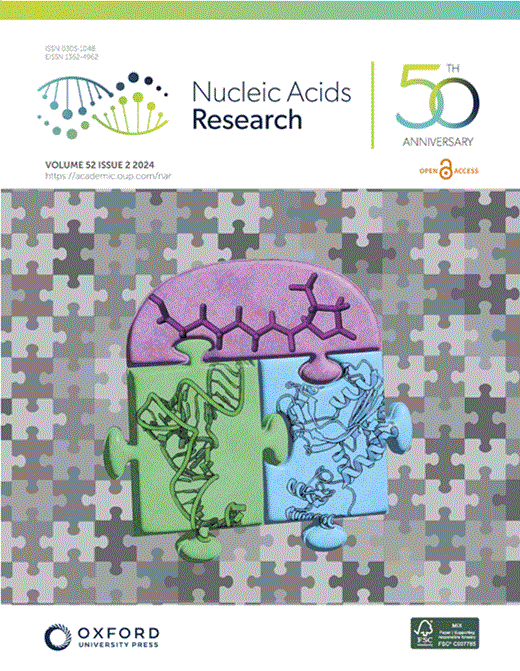DNA- pkcs /JNK/p53通路是DNA复制灾难中细胞命运决定死亡变化的基础。
IF 16.6
2区 生物学
Q1 BIOCHEMISTRY & MOLECULAR BIOLOGY
引用次数: 0
摘要
加剧癌细胞的DNA复制问题是一种可行的治疗方法。然而,癌症药物的细胞毒性经常受到治疗性衰老的阻碍,导致患者预后不良。在这里,我们采用急性复制体功能障碍联合共济失调毛细血管扩张和rad3相关(ATR)抑制作为一种策略,通过触发DNA复制灾难(一种由过量单链DNA (ssDNA)积累引起的不可逆复制叉崩溃)来转移衰老细胞走向死亡。rna测序揭示了一组独特的p53应答基因与死亡有关。我们发现c-Jun n-末端激酶(JNK)对于增加p53依赖性的凋亡程序和诱导γ - h2ax的泛核分布至关重要,共同构成一个前馈回路来驱动细胞死亡。DNA-PKcs的激活启动了复制灾难的信号级联,包括chk1依赖的JNK激活,它依赖于MRE11和PARP1来扩大和识别ssDNA缺口,将复制相关的缺口定义为复制灾难的潜在基础。我们的研究阐明了DNA-PKcs/JNK/p53轴上的近端和远端效应物的动态调控,这些效应物控制着细胞在衰老和死亡之间的命运决定。我们提出复制突变信号的关键决定因素是可靶向的脆弱性,可以利用这些脆弱性来限制衰老细胞群并提高抗癌治疗的功效。本文章由计算机程序翻译,如有差异,请以英文原文为准。
The DNA-PKcs/JNK/p53 pathway underlies changes in cell fate decision toward death during DNA replication catastrophe.
Exacerbating the DNA replication problems of cancer cells serves as a viable therapeutic approach. Nevertheless, the cytotoxicity of cancer drugs is often hampered by therapy-induced senescence, leading to unfavorable patient outcomes. Here, we employ acute replisome dysfunction in combination with Ataxia telangiectasia and Rad3-related (ATR) inhibition as a strategy to divert senescent cells toward death by triggering DNA replication catastrophe, a form of irreversible replication fork collapse caused by excessive single-stranded DNA (ssDNA) accumulation. RNA-sequencing revealed a distinct set of p53-responsive genes responsible for death. We identify c-Jun N-terminal kinase (JNK) to be essential for augmenting p53-dependent apoptotic programs and inducing pan-nuclear distribution of γH2AX, together constituting a feed-forward loop to drive cell death. Activation of DNA-PKcs initiates the signaling cascade of replication catastrophe, including CHK1-dependent JNK activation, which relies on MRE11 and PARP1 to expand and recognize ssDNA gaps, defining replication-associated gaps as an underlying basis for replication catastrophe. Our study elucidates the dynamic regulation of proximal and distal effectors along the DNA-PKcs/JNK/p53 axis that govern the cell fate decision between senescence and death. We propose that key determinants of replication catastrophe signaling are targetable vulnerabilities that can be exploited to limit senescent cell populations and increase the efficacy of anti-cancer therapies.
求助全文
通过发布文献求助,成功后即可免费获取论文全文。
去求助
来源期刊

Nucleic Acids Research
生物-生化与分子生物学
CiteScore
27.10
自引率
4.70%
发文量
1057
审稿时长
2 months
期刊介绍:
Nucleic Acids Research (NAR) is a scientific journal that publishes research on various aspects of nucleic acids and proteins involved in nucleic acid metabolism and interactions. It covers areas such as chemistry and synthetic biology, computational biology, gene regulation, chromatin and epigenetics, genome integrity, repair and replication, genomics, molecular biology, nucleic acid enzymes, RNA, and structural biology. The journal also includes a Survey and Summary section for brief reviews. Additionally, each year, the first issue is dedicated to biological databases, and an issue in July focuses on web-based software resources for the biological community. Nucleic Acids Research is indexed by several services including Abstracts on Hygiene and Communicable Diseases, Animal Breeding Abstracts, Agricultural Engineering Abstracts, Agbiotech News and Information, BIOSIS Previews, CAB Abstracts, and EMBASE.
 求助内容:
求助内容: 应助结果提醒方式:
应助结果提醒方式:


